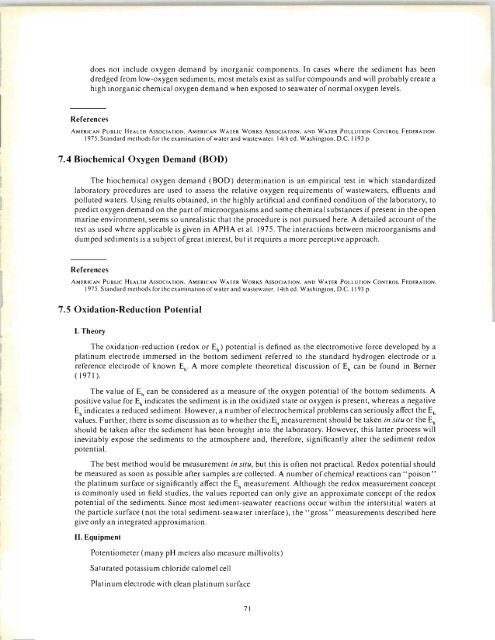You also want an ePaper? Increase the reach of your titles
YUMPU automatically turns print PDFs into web optimized ePapers that Google loves.
does not include oxygen demand by inorganic components. In cases where the sediment has been<br />
dredged from low-oxygen sediments, most metals exist as sulfur compounds and will probably create a<br />
high inorganic chemical oxygen demand when exposed to seawater of normal oxygen levels.<br />
References<br />
AMERICAN PUBLIC HEALTH ASSOCIATION. AMERICAN WATER WORKS ASSOCIATION. AND WATER POLLUTION CONTROL FEDERATION.<br />
1975. Siandard methods ror the examinalion or water and wastewater. 14th ed. Washinglon. D.C. I 193 p.<br />
7.4 Biochemical Oxygen Demand (BOD)<br />
The biochemical oxygen demand (BOD) determination is an empirical test in which standardized<br />
laboratory procedures are used to assess the relative oxygen requirements of wastewaters, effluents and<br />
polluted waters. Using results obtained, in the highly artificial and confined condition of the laboratory, to<br />
predict oxygen demand on the part of microorganisms and some chemical substances if present in the open<br />
marine environment, seems so unrealistic that the procedure is not pursued here. A detailed account of the<br />
test as used where applicable is given in APHA et al. 1975. The interactions between microorganisms and<br />
dumped sediments is a subject of great interest, but it requires a more perceptive approach.<br />
References<br />
AMERICAN PUBLIC HEALTH ASSOCIATION. AMERICAN WATER WORKS ASSOCIATION. AND WATER POLLUTION CONTROL FEDERATION.<br />
1975. Standard methods ror the examination or water and wastewater. 14th ed. Washington. D.C. 1193 p.<br />
7.S Oxidation-Reduction Potential<br />
I. Theory<br />
The oxidation-reduction (redox or E h ) potential is defined as the electromotive force developed by a<br />
platinum electrode immersed in the bottom sediment referred to the standard hydrogen electrode or a<br />
reference electrode of known E h . A more complete theoretical discussion of Eh can be found in Berner<br />
( 1971 ).<br />
The value of Eh can be considered as a measure of the oxygen potential of the bottom sediments. A<br />
positive value for Eh indicates the sediment is in the oxidized state or oxygen is present, whereas a negative<br />
Eh indicates a reduced sediment. However, a number of electrochemical problems can seriously affect the Eh<br />
values. Further, there is some discussion as to whether the E;, measurement should be taken in situ or the Eh<br />
should be taken after the sediment has been brought into the laboratory. However, this latter process will<br />
inevitably expose the sediments to the atmosphere and, therefore, significantly alter the sediment redox<br />
potential.<br />
The best method would be measurement in situ, but this is often not practical. Redox potential should<br />
be measured as soon as possible after <strong>samples</strong> are collected. A number of chemical reactions can" poison"<br />
the platinum surface or significantly affect the Eh measurement. Although the redox measurement concept<br />
is commonly used in field studies, the values reported can only give an approximate concept of the redox<br />
potential of the sediments. Since most sediment-seawater reactions occur within the interstitial waters at<br />
the particle surface (not the total sediment-seawater interface), the "gross" measurements described here<br />
give only an integrated approximation.<br />
n. Equipment<br />
Potentiometer (many pH meters also measure millivolts)<br />
Saturated potassium chloride calomel cell<br />
Platinum electrode with clean platinum surface<br />
71

















